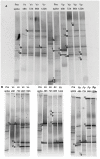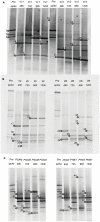Predatory Bacteriovorax communities ordered by various prey species
- PMID: 22461907
- PMCID: PMC3312913
- DOI: 10.1371/journal.pone.0034174
Predatory Bacteriovorax communities ordered by various prey species
Abstract
The role of predation in altering microbial communities has been studied for decades but few examples are known for bacterial predators. Bacteriovorax are halophilic prokaryotes that prey on susceptible gram-negative bacteria. We recently reported novel observations on the differential selection of Bacteriovorax phylotypes by two different prey, Vibrio parahaemolyticus and Vibrio vulnificus. However, the conclusion is restricted by the limited number of prey tested. In this study, we have conducted two independent investigations involving eight species of prey bacteria while using V. vulnificus and V. parahaemolytics as reference strains. Water samples collected from Dry Bar, Apalachicola Bay were used to establish microcosms which were respectively spiked with prey strains Vibrio cholerae, Escherichia coli or Pseudomonas putida to examine the response of native Bacteriovorax to freshwater bacteria. Indigenous Vibrio sp., Pseudoalteromonas sp., Photobacterium sp. and a clinical strain of V. vulnificus were also tested for the impact of saltwater prey on the Bacteriovorax community. At 24 hour intervals, optical density of the microcosm samples and the abundance of Bacteriovorax were measured over five days. The predominant Bacteriovorax plaques were selected and analyzed by 16S rRNA gene amplification and sequencing. In addition, the impacts of prey on predator population and bacterial community composition were investigated using culture independent denaturing gradient gel electrophoresis. Strikingly, Cluster IV was found consistently as the predominant phylotype produced by the freshwater prey. For all saltwater prey, subgroups of Bacteriovorax phylotype IX were the major predators recovered. The results suggest that prey is an important factor along with temperature, salinity and other environmental parameters in shaping Bacteriovorax communities in aquatic systems.
Conflict of interest statement
Figures







Similar articles
-
Prey bacteria shape the community structure of their predators.ISME J. 2011 Aug;5(8):1314-22. doi: 10.1038/ismej.2011.4. Epub 2011 Feb 17. ISME J. 2011. PMID: 21326335 Free PMC article.
-
Halobacteriovorax isolated from marine water of the Adriatic sea, Italy, as an effective predator of Vibrio parahaemolyticus, non-O1/O139 V. cholerae, V. vulnificus.J Appl Microbiol. 2018 Oct;125(4):1199-1207. doi: 10.1111/jam.14027. Epub 2018 Sep 2. J Appl Microbiol. 2018. PMID: 29931749
-
Phylogenetic relationships amongst the saltwater members of the genus Bacteriovorax using rpoB sequences and reclassification of Bacteriovorax stolpii as Bacteriolyticum stolpii gen. nov., comb. nov.Int J Syst Evol Microbiol. 2008 May;58(Pt 5):1203-9. doi: 10.1099/ijs.0.65710-0. Int J Syst Evol Microbiol. 2008. PMID: 18450714
-
Niche partition of Bacteriovorax operational taxonomic units along salinity and temporal gradients in the Chesapeake Bay reveals distinct estuarine strains.Microb Ecol. 2013 Apr;65(3):652-60. doi: 10.1007/s00248-013-0186-3. Epub 2013 Mar 6. Microb Ecol. 2013. PMID: 23463183
-
Environmental Regulation of the Distribution and Ecology of Bdellovibrio and Like Organisms.Front Microbiol. 2020 Oct 29;11:545070. doi: 10.3389/fmicb.2020.545070. eCollection 2020. Front Microbiol. 2020. PMID: 33193128 Free PMC article. Review.
Cited by
-
Comparative analysis of novel Pseudobdellovibrionaceae genera and species yields insights into the genomics and evolution of bacterial predation mode.bioRxiv [Preprint]. 2025 Feb 20:2025.02.19.638989. doi: 10.1101/2025.02.19.638989. bioRxiv. 2025. PMID: 40027812 Free PMC article. Preprint.
-
Iron Flocs and the Three Domains: Microbial Interactions in Freshwater Iron Mats.mBio. 2020 Dec 15;11(6):e02720-20. doi: 10.1128/mBio.02720-20. mBio. 2020. PMID: 33323508 Free PMC article. Review.
-
Unexpected host dependency of Antarctic Nanohaloarchaeota.Proc Natl Acad Sci U S A. 2019 Jul 16;116(29):14661-14670. doi: 10.1073/pnas.1905179116. Epub 2019 Jun 28. Proc Natl Acad Sci U S A. 2019. PMID: 31253704 Free PMC article.
-
A New Comparative-Genomics Approach for Defining Phenotype-Specific Indicators Reveals Specific Genetic Markers in Predatory Bacteria.PLoS One. 2015 Nov 16;10(11):e0142933. doi: 10.1371/journal.pone.0142933. eCollection 2015. PLoS One. 2015. PMID: 26569499 Free PMC article.
-
Draft Genome Sequence of the Predatory Marine Bacterium Halobacteriovorax sp. Strain JY17.Genome Announc. 2018 Jan 4;6(1):e01416-17. doi: 10.1128/genomeA.01416-17. Genome Announc. 2018. PMID: 29301887 Free PMC article.
References
-
- Pernthaler J. Predation on prokaryotes in the water column and its ecological implications. Nature Reviews Microbiology. 2005;3:537–546. - PubMed
-
- Yair S, Yaacov D, Susan K, Jurkevitch E. Small eats big: ecology and diversity of Bdellovibrio and like organisms, and their dynamics in predator-prey interactions. Sustainable Agriculture. 2009:275–284.
-
- Stolp H, Petzold H. Untersuchungen uber einen obligat parasitischen Mikroorganismus mit lytischer Aktivitat fur Pseudomonas-Bakterien. Phytopathol. 1962;45:364–390.
-
- Proctor LM, Fuhrman JA. Viral mortality of marine bacteria and cyanobacteria. Nature. 1990;343:60–62.
-
- Maranger R, Bird DF. Viral abundance in aquatic systems: a comparison between marine and fresh waters. Marine ecology progress series Oldendorf. 1995;121:217–226.
Publication types
MeSH terms
Substances
LinkOut - more resources
Full Text Sources
Molecular Biology Databases

